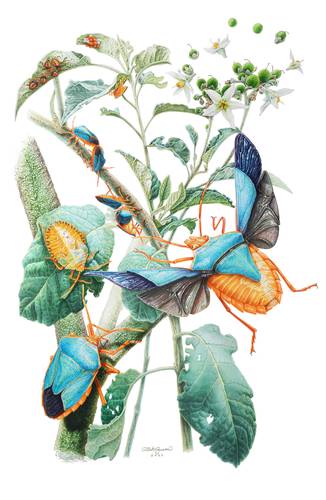Scientific illustrators face several challenges in the context of climate change and the development of artificial intelligence (AI). In the former case, the challenges range from documenting endangered species, with accurate illustrations and up-to-date information, to visually communicating the impacts of alteration in the habitats and distributions of many species, in a way that is understandable to the general public.
In the second area, the goal is to familiarize oneself with new tools and technologies to improve and speed up one’s work, to the point of developing the ability to balance scientific precision with technological innovation, agreed María Teresa Jiménez Segura, assigned to the Institute of Ecology AC, in Veracruz, and Alberto Guerra, a specialist in drawing marine fauna and collaborator at the Faculty of Sciences of the National Autonomous University of Mexico (UNAM) in Yucatán.
In a separate interview, Alberto Guerra defined a scientific illustrator as a professional who creates detailed visual representations of plants, animals, anatomical structures, biological processes, and other natural phenomena, useful for transmitting knowledge in publications, textbooks, magazine articles, museums, and educational materials.
He considered that the main contribution of graphic artists, They have the function of translating knowledge into a visual language, in order to facilitate its understanding.
.
For Guerra, the profession is experiencing a boom in Mexico, and from being a guild of just 20 people in 2000, by 2024 there will be 200 interpreters and illustrators.
Regarding the challenges that climate change imposes on these professionals, Jiménez Segura said that the main thing is to reflect on what is our role or responsibility as scientific illustrators in this context? In the end, we are communicators and our representations, beyond being beautiful, have to fulfill a communicative objective of raising awareness about this problem and inciting public action.”
She said another important point is to encourage close collaboration with researchers and other illustrators to have the most up-to-date information and to address complex issues of conservation and climate change in their images.
▲ Red-edged bug illustration.Photo courtesy of Alberto Guerra
In his turn, Alberto Guerra observed that Although we are very aware of the term climate change, we often do not understand what it is, what factors cause it, and what its repercussions are. This is where we have a key role to play in helping experts on the subject explain this phenomenon to society in general.
.
He added that the challenge is to bring information to a wide audience and ensure that this problem is better understood, It is our mission to generate graphic representations to raise awareness among the population, and to do so, we have to work closely with scientists, because only this partnership can generate awareness.
.
Faced with the rise of new technologies and AI, Jiménez Segura, who creates graphics for the Flora of Veracruza work that has been published since 1978 and is dedicated to the taxonomic revision of plants in the region, considers that moving from freehand drawing to using digital design tools is a positive thing, since it allows for speeding up work and shortening production times.
He considered that the main thing for the union is to overcome resistance and train in the use of new technologies and softwareto enrich their work, These advances must be thought of as facilitators of certain processes
.
In turn, Alberto Guerra mentioned that since the work of the creators involves representing nature as faithfully and realistically as possible, AI at this level cannot replicate the human understanding behind a scientific illustration, but it can help us to have references or get closer to a context.
.
One aspect that must be taken into account when using new technological platforms or image banks, he said, is to avoid vices such as plagiarism of images or distancing oneself from scientific rigor when making representations.
